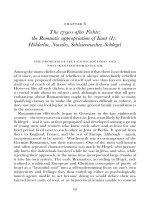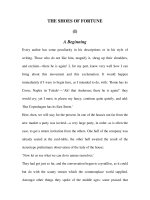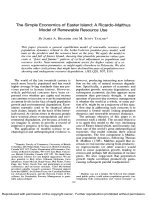Shaking a box of sand I – a simple lattice model
Bạn đang xem bản rút gọn của tài liệu. Xem và tải ngay bản đầy đủ của tài liệu tại đây (161.29 KB, 10 trang )
7
Shaking a box of sandI–asimplelattice model
7.1 Introduction
Vibrating sand results in very varied dynamics, ranging from glassy [132, 172, 173]
to fluidised [193–197]. In much of this book, we will focus on the former, while
a subsequent chapter will contain a review of the latter regime. Of course, it is
important to have a theoretical understanding of how one regime gives way to the
other; it is for this reason that the model discussed in this chapter is a simple model
of a vibrated sandbox, which interpolates between the glassy and fluidised regimes
through an extremely interesting intermediate regime, whose properties are not
fully understood to date, and are the subject of current investigations.
The model [174] is based on the generalisation of an earlier cellular automaton
(CA) model [22, 75, 83, 165] of an avalanching sandpile. This version of the model
contains only near-neighbour interactions, with grains being in one of two orienta-
tional states. It shows both fast and slow dynamics in the appropriate regimes and,
in its simplest form, reduces to an exactly solvable model in the frozen or jammed
regime. Of course, in order to replicate the truly glassy behaviour of the jammed
regime, one needs to introduce true long-range interactions. This will be done in
the next chapter, where in particular the effect of grain shapes will be probed using
an extension of this model [34, 35].
7.2 Definition of the model
As mentioned above, a principal motivation for this model is the addition of ori-
entational rearrangement to the normal flow mechanism of CA models. In this
spirit, consider a rectangular lattice of height H and width W with N ≤ HW
grains located at its lattice points. Each ‘grain’ is a rectangle with sides 1 and
a ≤ 1, respectively, so that a grain which lies on its long(short) side is said to be
Granular Physics, ed. Anita Mehta. Published by Cambridge University Press.
C
A. Mehta 2007.
94
7.2 Definition of the model 95
∆ h
∆H
Fig. 7.1 A vertical grain needs to be tilted through the height h to reach the
unstable equilibrium position and flop to the horizontal, while a horizontal grain
needs to be tilted through an additional height H to reach the vertical.
horizontal(vertical). Let this box be shaken with vibration intensity . The most
intuitively reasonable rules for its dynamics should involve (a) grains falling under
gravity to a void below (without thresholds) or diagonally adjacent (provided appro-
priate height thresholds are met, as in usual CA models [65]); (b) grains flying
directly or diagonally above themselves, provided they are given sufficient energy
by the vibration intensity ; (c) grains flipping easily to their horizontal orientation,
and flipping back less easily to their vertical one (Fig. 7.1); and (d) vertical grains
being more unstable, they should add to the height of the column, and thus increase
the grain’s propensity to fall to sites which are diagonally below them, i.e. ‘down
the pile’.
We write below the mathematical formulation of these rules; consider a grain
(i, j)inrowi, column j whose height at any given time is given by h
ij
= n
ij−
+
an
ij+
, with n
ij−
the number of vertical grains and n
ij+
the number of horizontal
grains below (i, j). We give in the following a prescription [174] for the dynamics
of this grain under shaking:
r
If lattice sites (i + 1, j − 1), (i + 1, j), or (i + 1, j + 1) are empty, grain (i, j ) moves
there with a probability exp(−1/), in units such that the acceleration due to gravity, the
mass of a grain, and the height of a lattice cell all equal unity.
r
If the lattice site (i − 1, j) below the grain is empty, it will fall down.
r
If lattice sites (i − 1, j ± 1) are empty, the grain at height h
ij
will fall to either lower
neighbour, provided the height difference h
ij
− h
i−1, j±1
≥ 2.
r
The grain flips from horizontal to vertical with probability exp(−m
ij
(H + h)/),
where m
ij
is the mass of the pile (consisting of grains of unit mass) above grain (i, j). For
a rectangular grain, H = 1 − a is the height difference between the initial horizontal
and the final vertical state of the grain. Similarly, the activation energy for a flip reads
h = b − 1, where b =
√
1 + a
2
is the diagonal length of a grain.
r
The grain flips from vertical to horizontal with probability exp(−m
ij
h/).
In this form, although the interactions are nearest, or at most next-nearest neigh-
bour, the model is not exactly solvable, because of the presence of voids in the
system. The solutions in much of this chapter will therefore be largely numerical,
with an analytical solution obtained only when voids are strictly absent.
96 Shaking a box of sandI–asimplelattice model
123456789
ln t
−1.0
−0.5
0.0
0.5
φ−φ
00
0.1
0.2
0.5
1.0
2.0
3.0
5.0
Fig. 7.2 Plot of φ − φ
∞
versus ln t, for different values of , indicated on the
curves. Note that φ
∞
decreases with increasing , and is thus distinct for each
curve.
7.3 Results I: on the packing fraction
In this section, we examine the behaviour of the packing fraction of the model, as
a function of the vibration intensity .LetN
−
and N
+
be the numbers of vertical
and horizontal grains in the box. The packing fraction φ is:
φ =
N
+
− aN
−
N
+
+ aN
−
, (7.1)
which we use as an order parameter. The vertical orientation of a grain thus wastes
space proportional to 1 − a, relative to the horizontal one.
We examine the response of the packing fraction for typical parameter values
(H = 0.3, h = 0.05) to shaking at varying intensities in Fig. 7.2. Clearly, the
asymptotic values of the packing fraction φ
∞
will differ for each intensity; in fact,
as was shown in earlier chapters, it decreases with increasing intensity [61, 62,
130]. The asymptotic packing fraction was determined for each intensity, and the
difference φ − φ
∞
plotted as a (logarithmic) function of time T in Fig. 7.2. Note
that the initial packing fraction was the same in each case.
The dynamical response of the shaken sandbox [174] includes three distinct
regions, each illustrated by representative curves in the figure. We note first a
fluidised region (for 1), where we observe an initial increase (caused by a
nonequilibrium and transient ‘ordering’ of grains in the boundary layer) of the
packing fraction that quickly relaxes to the equilibrium values φ
∞
in each case.
This overshooting effect in Fig. 7.2 increases with , since grains ever deeper in
the sandbox can now overcome their activation energy to relax to the horizontal. This
inhomogeneous relaxation has been mentioned in earlier chapters, and observed
in computer simulations of shaken spheres [131]. Very strikingly, the overshoot
has also been observed in the context of a totally different model, the random
graphs model of granular compaction [152, 153]. To date there is no satisfactory
7.4 Results II: on annealed cooling 97
quantitative explanation for this overshoot, which seems firmly established in view
of its model-independence.
Next, note an intermediate region (for ≈ 1), where the packing fraction
remains approximately constant in the bulk, while the surface equilibrates via the
fast dynamics of single-particle relaxation. The specific φ
∞
at which this occurs
(0.917 here), is the single-particle relaxation threshold density (SPRT) observed in
Ref. [152, 153]; nonequilibrium, non-ergodic, fast dynamics allows single particles
locally to find their equilibrium configurations at this density. Analogous effects
have been observed in recent experiments on colloids [124], where the correlated
dynamics of fast particles was seen to be responsible for most relaxational behaviour
before the onset of the glass transition. Once again, the non-ergodic dynamics in
the vicinity of the SPRT is very poorly understood, at the time of writing this book.
Additionally, this intermediate regime, with properties in between the jammed and
fluidised states, with its balance of individual and collective dynamics, remains one
of the most fascinating mysteries of granular matter.
Lastly, we see a frozen region (for 1), where the slow dynamics of the
system results in a logarithmic growth of packing fraction with time:
φ − φ
∞
= b()lnt + a, (7.2)
where b() increases with , in good agreement with experiment [172, 173]. The
slow dynamics has been identified in a previous chapter with a cascade process,
where the free volume released by the relaxation of one or more grains allows for the
ongoing relaxation of other grains in an extended neighbourhood. As decreases,
the corresponding φ
∞
increases asymptotically towards the jamming limit φ
jam
,
identified with a dynamical phase transition in a previous chapter [152, 153].
7.4 Results II: on annealed cooling, and the onset of jamming
We next investigate the analogue of ‘annealed cooling’, where is increased and
decreased cyclically, and the response of the packing fraction observed [172, 173].
The results obtained here are similar to those [131] seen using more realistic mod-
els of shaken spheres, but the simplicity of the present model allows for greater
transparency.
Starting with the sand in a fluidised state, as in experiment [172, 173], the sandbox
is submitted to taps at a given intensity for a time t
tap
and the intensity is increased
in steps of δ; at a certain point, the cycle is reversed, to go from higher to lower
intensities. The entire process is then iterated twice. Figure 7.3 shows the resulting
behaviour of the volume fraction φ as a function of , where an ‘irreversible’
branch and a ‘reversible’ branch of the compaction curve are seen, which meet at
98 Shaking a box of sandI–asimplelattice model
0246810
Γ
−0.5
0.0
0.5
1.0
φ
1 −>
2 <−
3 −>
4 <−
5 −>
6 <−
1234
5
Fig. 7.3 Hysteresis curves. Left: = 0.1, t
tap
= 2000 time units. Right: =
0.001, t
tap
= 10
5
time units. Note the approach of the irreversibility point
∗
to
the ‘shoulder’
jam
, as the ramp rate δ/t
tap
is lowered.
the ‘irreversibility point’
∗
[172, 173]. The left- and right-hand sides of Fig. 7.3
correspond respectively to high and low values of the ‘ramp rate’ δ/t
tap
[172, 173].
As the ramp rate is lowered, we note that the width of the hysteresis loop in the
so-called reversible branch decreases. The ‘reversible’ branch is thus not reversible
at all; hard-sphere simulations of shaken spheres [61, 62, 130] confirm the first-
order, irreversible nature of the transition. As mentioned in an earlier chapter, the
density may attain values that are substantially higher than random close packing,
and quite close to the crystalline limit [131, 132]. An analogous transition has also
been observed experimentally in the compaction of rods [133]. Note also that the
‘irreversibility point’
∗
(the shaking intensity at which the irreversible branch
and the reversible branch meet) approaches
jam
(the shaking intensity at which
the jamming limit φ
jam
is approached), in agreement with results on other discrete
models [190].
Of course, as mentioned in an earlier chapter, this feature is an idealisation; in
reality the transition to the crystalline limit is not approached quite so smoothly as
predicted here, since force networks act as mechanical impediments. However, it is
interesting to see how the simple use of phenomenology in this model can get some
of the results that are more cumbersomely obtained from hard-sphere simulations.
We next use the simplicity of the model to explore the onset of jamming, probing
in between the regimes where fast and slow dynamics respectively predominate.
This is explored via a configurational overlap function
χ(t
ref
,t) =
1
N
i, j
[B
i, j
(t
ref
), B
i, j
(t
ref
+ t)]. (7.3)
Here B
i, j
(t) can take three distinct values depending on whether the lattice site
(i, j) at time t is (a) empty, (b) occupied by a + grain, or (c) occupied by a − grain;
[X, Y ] = 1 − δ
X,Y
; i.e., [X, Y ] = 0ifX = Y ; and t is the time lag. The func-
tion χ(t
ref
,t) is therefore 0 when configurations are identical at t
ref
and t
ref
+ t









